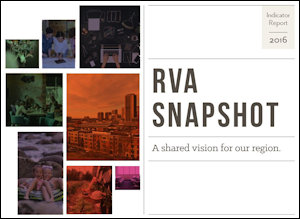The Capital Region Collaborative, a not-for-profit dedicated to building a more livable, prosperous Richmond region, has just published RVA Snapshot, a set of metrics that compares Richmond to six peer metros of comparable size. The accompanying commentary summarizes the conventional wisdom regarding the region’s strengths and weaknesses, and articulates a “shared vision” for the future.
I find the aspirations particularly interesting, as they express the values of the business, political and civic leaders who influence how the region allocates resources to advance the public good.
Education: The region ensures that every child graduates from high school college or career ready.
Job creation: The region enjoys a diverse economy that is competitive in the global marketplace and provides job opportunities for all.
Workforce preparation: The region aligns workforce skills to employer needs.
Social stability: The region embraces our social diversity as a strong community asset and supports a community where all residents have the opportunity to succeed.
Healthy community: The region transforms into a metro area known for an active lifestyle.
Coordinated transportation: The region maintains its status as one of the most uncongested transportation networks in the country while supporting all modes of transportation.
James River: The region will make the James River a centerpiece for entertainment, recreation, and commerce.
Quality of place: The region is the most appealing and attractive destination for arts, culture and entertainment on the East Coast.
By necessity, these aspirations are watered down to appeal to a broad cross section of the population. It’s hard even for a curmudgeon like me to take exception to any of them. The tricky part is figuring out which tangible actions will advance these goals. And that often boils down to political philosophy — what role should government play? To what extent does the community achieve its goals by taxing, spending and regulating, and to what extent does it rely upon voluntary, bottom-up initiatives?
Needless to say, I favor voluntary, bottom-up initiatives. For example, the Capital Area Farmer Markets Association is creating a food guide listing all restaurants, farms, grocers, markets and other businesses where consumers can purchase local food. I doubt I’ll go out of my way to patronize these establishments, but if other people do, that’s great! I’m all for increasing consumer choices.
I’m less excited by the uncritical emphasis on public transit, which the document kinda, sorta endorses by noting that the Richmond region is 8th lowest ranked among its peers with regard to transit coverage and job access. That may be true, and creating affordable transportation options for the public may be desirable, but expanding mass transit is not a win-win proposition, it’s a win-lose. Money is involuntarily transferred from one group of people (taxpayers) to another group of people (transit riders), usually with little regard to economic efficiency or emerging transportation alternatives.
Regardless, all the right-thinking people in Richmond are lining up behind Richmond’s proposed bus rapid transit system. I have yet to see a discussion of appropriate land uses along the bus corridor or streetscape improvements needed to make the corridor more hospitable for passengers walking from the stations to their destination. Nor has anyone considered how the Uber revolution might be extended to privately operated vans and buses as a way to provide affordable transportation access to the poor. Having dealt with none of these issues, the City of Richmond will incur a long-term obligation to continue operating a money-losing service.
Which brings me to my final point: RVA Snapshot gives no consideration to the long-term fiscal health of local governments in the region. Apparently, is it assumed that AAA and AA bond ratings are a birthright that require no special attention. Trouble is, local governments are hard-pressed to maintain the services at current tax rates without expanding their commitments and setting themselves up for future failure. Sound finances are the bedrock of any community’s long-term prosperity. I would add the following aspiration:
Fiscal health: The region embraces sound fiscal practices that support the ability of local governments to maintain competitive tax rates and pursue excellence in core functions over the long run.



